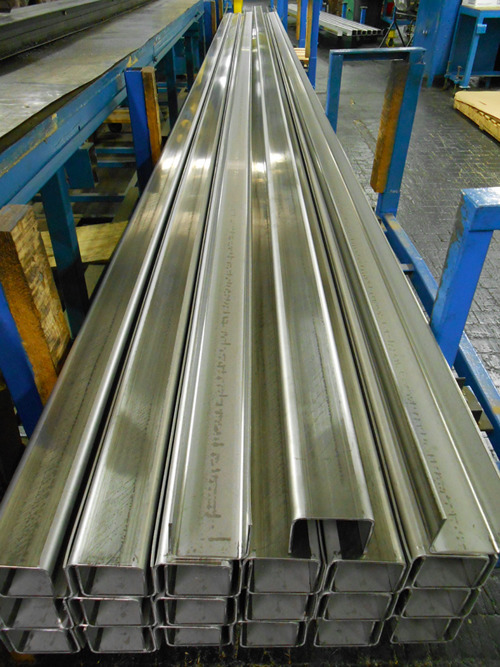A roll forming machine (or metal forming machine) fabricates specific configurations out of long strips of metal, most commonly coiled steel. In most applications, the required cross-section profile of the piece is specifically designed for the machine to bend the metal as necessary. Other than roll forming, these machines perform a number of metalworking duties, including material cutting and roll punching.
Roll forming machines, for the most part, work in a continuous cycle. The material is fed into the machine where it continuously makes its way through the stages of each operation, ending with the completion of a final product.
How Roll Forming Machines Work
Roll-formed beam
Image Credit: Premier Products of Racine, Inc
A roll forming machine bends metal at room temperature using a number of stations where fixed rollers both guide the metal and make the necessary bends. As the strip of metal travels through the roll forming machine, each set of rollers bend the metal a little more than the previous station of rollers.
This progressive method of bending metal ensures that the correct cross-sectional configuration is achieved, while maintaining the cross-sectional area of the work piece. Typically operating at speeds between 30 to 600 feet per minute, roll forming machines are a good choice for manufacturing large quantities of parts or very long pieces.
Roll forming machines are also good for creating precise parts that require very little, if any, finishing work. In most cases, depending upon the material being shaped, the end product features an excellent finish and very fine detail.
Roll Forming Basics and the Roll Forming Process
The basic roll forming machine has a line that can be separated into four major parts. The first part is the entry section, where the material is loaded. The material is usually inserted in sheet form or fed from a continuous coil. The next section, the station rollers, is where the actual roll forming takes place, where the stations are located, and where the metal shapes as it makes its way through the process. Station rollers not only shape the metal, but are the main driving force of the machine.
The next section of a basic roll forming machine is the cut off press, where the metal is cut to a pre-determined length. Due to the speed at which the machine works and the fact that it is a continuously working machine, flying die cut-off techniques are not uncommon. The final section is the exit station, where the finished part exits the machine onto a roller conveyor or table, and is manually moved.
Roll Forming Machine Developments
Today's roll forming machines feature computer-aided tooling designs. By incorporating CAD/CAM systems into the roll forming equation, machines function at their maximum potential. Computer-controlled programming provides roll forming machines with an internal "brain" that catches product imperfections, minimizing damage and waste.
In many modern roll forming machines, programmable logic controllers ensure accuracy. This is vital if a part needs multiple holes or needs to be cut to a specific length. The programmable logic controllers tighten tolerance levels and minimize accuracy.
Some roll forming machines also feature laser or TIG welding capabilities. Including this option on the actual machine results in loss of energy efficiency, but removes an entire step in the manufacturing process.
Roll Forming Machine Tolerances
Dimensional variation of a part created through roll forming is based on the type of material used, the roll forming equipment, and the actual application. Tolerances can be influenced by varying metal thickness or width, material springback during production, the quality and wear of the tooling, actual machine condition, and the experience level of the operator.
The Benefits of Roll Forming Machines
Aside from the benefits discussed in the previous section, roll forming machines offer the user some specific advantages. Roll forming machines are energy efficient because they do not expend energy to heat material—the metal shapes at room temperature.
Roll forming is also an adjustable process and is applicable to projects of varying time duration. Additionally, roll forming results in a precise, uniform part.
Post time: Jun-19-2023



